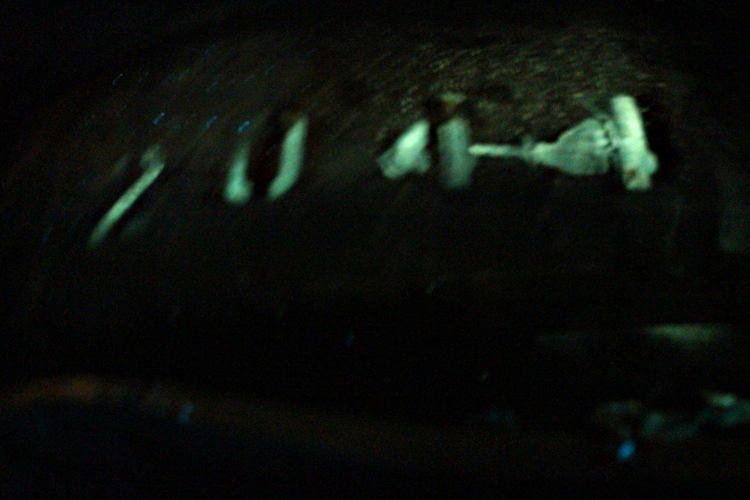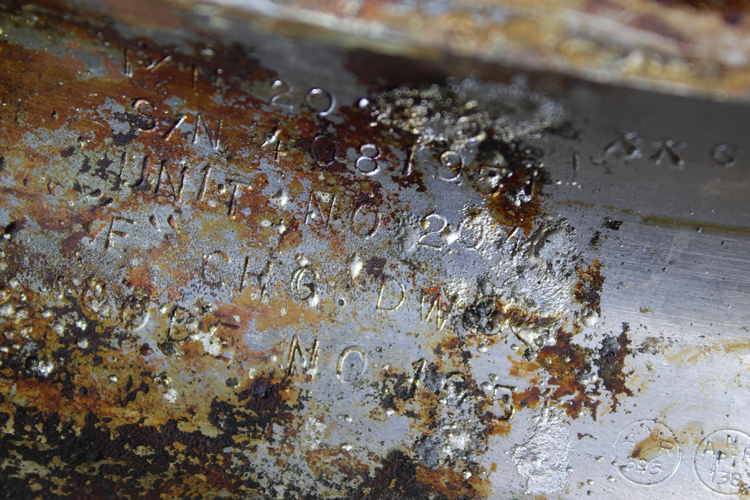SERIAL NUMBER 2044
http://www.bezosexpeditions.com/updates.html

Blacklight w/filter

Recovered
Posted on 07/19/2013 4:13:18 PM PDT by servo1969
Bear with me, LI readers – I’m a little bit of a geek, so I find stories like these exciting. It might not be of interest to everyone, but I do think there’s one point about it that will resonate with all of you.
Amazon founder Jeff Bezos started Bezos Expeditions (as well as the space exploration venture Blue Origin) out of his “passions for science, engineering, and exploration.”
Bezos, like so many others, watched Apollo 11′s launch from his television as a child in 1969. Days prior, the mission began when five F-1 rocket engines fired together in a test by NASA, then landed in the ocean after passing that test successfully.
The Amazon founder pondered, “A year or so ago, I started to wonder, with the right team of undersea pros, could we find and potentially recover the F-1 engines that started mankind’s mission to the moon?”
In short, the answer is YES!
Bezos posted an update to his website today, announcing that one of the components his expedition team scooped from the ocean’s depths – they collected enough to “fashion displays of two flown F-1 engines” – has been confirmed as that of Apollo 11′s F-1 engine #5.
Today, I’m thrilled to share some exciting news. One of the conservators who was scanning the objects with a black light and a special lens filter has made a breakthrough discovery – “2044” – stenciled in black paint on the side of one of the massive thrust chambers. 2044 is the Rocketdyne serial number that correlates to NASA number 6044, which is the serial number for F-1 Engine #5 from Apollo 11. The intrepid conservator kept digging for more evidence, and after removing more corrosion at the base of the same thrust chamber, he found it – “Unit No 2044″ – stamped into the metal surface.44 years ago tomorrow Neil Armstrong stepped onto the moon, and now we have recovered a critical technological marvel that made it all possible. Huge kudos to the conservation team at the Kansas Cosmosphere and Space Center in Hutchinson, Kansas. Conservation is painstaking work that requires remarkable levels of patience and attention to detail, and these guys have both.
The discovery is a reminder of one of America’s most shining moments in the history of the world, when man walked on the moon.
And it comes at just the right time, as Bezos points out above.
From NBC News:
The age of the moonwalkers began on July 20, 1969, when Armstrong and crewmate Buzz Aldrin took humanity’s first small steps on the lunar surface. Since then, four of the 12 men who walked on the moon have passed away. The youngest of those who remain — Apollo 16′s Charlie Duke — is 77.
I can’t even fathom the excitement that Bezos and his team are feeling today. They’ve apparently discovered a piece of great American history. Congratulations to them.
SERIAL NUMBER 2044
http://www.bezosexpeditions.com/updates.html

Blacklight w/filter

Recovered
ping
/mark
Great post, thanks.
If memory serves those five F-1s were very thirsty, They burned fifteen tons of propellants per second, developing seven and a half million pounds of thrust, one hundred sixty million horsepower. I can’t comprehend why they didn’t collapse under all that pressure. In fact, the entire Apollo program still impresses me. Also impressive is the fact that all twelve men who walked on the moon were Americans.
White males, I hope you're showing the appropriate guilt over this stunning lack of diversity.....
That Saturn V was an amazing machine. You’re right, the numbers are mindboggling. The Sov’s gave up trying to build anything that powerful.
The F-1 burned 3,945 pounds (1,789 kg) of liquid oxygen and 1,738 pounds (788 kg) of RP-1 each second, generating 1,500,000 pounds-force (6.7 MN) of thrust. This equated to a flow rate of 413.5 US gallons (1,565 l) of LOX and 257.9 US gallons (976 l) RP-1 per second. During their two and a half minutes of operation, the five F-1s propelled the Saturn V vehicle to a height of 42 miles (68 km) and a speed of 6,164 miles per hour (9,920 km/h). The combined propellant flow rate of the five F-1s in the Saturn V was 3,357 US gallons (12,710 l) per second.[5] Each F-1 engine had more thrust than three Space Shuttle Main Engines combined.[6]
hey, star trek got us out of white guilt about space.
That was such a wonderful time for me, as an American teenager (the summer between eighth and ninth grade). Listening to these conversations brings so much of it back.
One thing I noticed: the hum. In all the audio recordings of Apollo-Houston conversations, there's a deep, ever-present hum that's not quite at the limit of audibility.
What struck me is that you would never hear that hum today; the reason is because all communications channels - including voice - would be digital in our time. Back then, they were analog. When you remember that it was often the case that Earth-crew communications were carried out via a huge dish antenna located somewhere other than in the continental US (I believe one such station was located in Woomera Australia) it is all the more amazing. Analog transmissions, over thousands of terrestrial miles. With so little hum.
This was more than a decade before NASA's TDRSS (digital) satellite system was put in orbit.
PLEASE put this on display.
I'd love to see it.
At one time, man decided to see just how far their reach could extend. And they stepped on the moon.
Because they were actually just five second stage J-2 engines in an identical configuration, just with big nozzles.
After all, the thing only had to get to orbit.
Thanks colorado tanker and KoRn, *another* extra to APoD members.
Mind boggling. Rockedyne used to have a dummy sitting out front of their San Fernando plant in the seventies.
As the saying goes: There is the money quote...........
Disclaimer: Opinions posted on Free Republic are those of the individual posters and do not necessarily represent the opinion of Free Republic or its management. All materials posted herein are protected by copyright law and the exemption for fair use of copyrighted works.